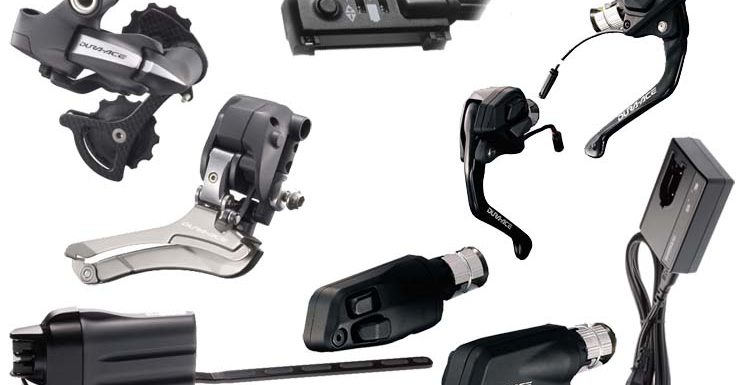
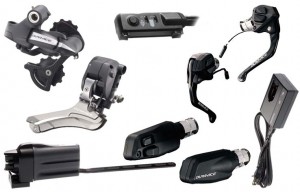 I learned quite a bit about Shimano Di2 when I installed one of the first available Time Trial/Triathlon groupsets on my Cervelo P2. I’ve subsequently answered a lot of questions on forums and article comments, and elsewhere. In doing so, I realized that people have a lot of questions about Di2 and the answers are difficult to find. This lead me to create this article, to consolidate everything I know and have been asked into one location so people can find answers. If you can’t find what you’re looking for below, please leave a comment and I’ll do my best to help.
I learned quite a bit about Shimano Di2 when I installed one of the first available Time Trial/Triathlon groupsets on my Cervelo P2. I’ve subsequently answered a lot of questions on forums and article comments, and elsewhere. In doing so, I realized that people have a lot of questions about Di2 and the answers are difficult to find. This lead me to create this article, to consolidate everything I know and have been asked into one location so people can find answers. If you can’t find what you’re looking for below, please leave a comment and I’ll do my best to help.
Index: There’s lots of info in this post, so here’s an Index to help you find specific sections:
- Di2 General Overview
- Compatibility: Between 6770 10-speed, 6780 11-speed, 9070 11-speed, first-gen 7970
- How to Check Battery Level
- How to Adjust Rear Derailleur Trim
- How to Adjust Front Derailleur Trim
- Dealer Installation Manuals
- Shimano E-tube Project Software – Change Settings and Update Firmware
- Chargers, PC USB Interfaces/Programmers
- Component Overviews
- Shift/Brake Levers
- Dedicated Shift Buttons
- Front Derailleurs
- Rear Derailleurs
- Display Units and ANT Bluetooth Wireless Communication Modules
- Batteries and Battery Mounts (Internal and External)
- Front Cable Connection A Junctions (with charger ports and LED status lights)
- Rear Cable Connect B Junctions
- Cables, Grommets, Cable Install Tools
- List of Components Needed to Build Your Own Di2 System
- Technical Details of the Di2 CANBUS protocol and signaling
System Overview: Shimano Di2 Dura-Ace 9150 and 9070 and Ultegra 6770 and 6870
The second generation Shimano Ultegra 6770/6870 and Dura-Ace 9070 “E-Tube” electronic bicycle shifting systems consist of battery-powered electric derailleurs activated by handlebar mounted push buttons. Power and shift commands are sent via a 2-wire CAN (Controller Area Network) datalink contained within a single cable housing. This design has several advantages over conventional mechanical shifting systems, the most notable of which are:
- Extremely low shifting effort, which generally results in more frequent shifts and therefore better gear ratio selection.
- Greatly improved shift quality, especially for the front derailleur chainrings, allowing shifting under full power with almost no chance of a dropped chain.
- Shifting is available at multiple positions on the handlebars, for example, at the end of the time trial aero bars, on the brake levers, up to in climbing position, and down low the sprint position.
- Automatic trimming of the front derailleur position as the rear derailleur moves back and forth between the smaller and bigger gears. This eliminates unintended contact (and noise) between the front derailleur and the chain.
- Lighter weight vs. equivalent mechanical system. The Shimano Dura-Ace Di2 9070 electronic groupset with internal battery weighs 2047 grams; the Shimano Dura-Ace 9000 mechanical groupset weighs 2074 grams (27 grams more than Di2.)
- Multi-Shift: Pressing and holding a rear derailleur shift button results in shifts through multiple gears. The rate of shifts can be configured using the PC computer interface cable and the free Shimano E-tube Project software.
- Synchronized Shifting: Starting with Dura-Ace 9150, automated Synchronized Sifting of the front derailleur is an option. Two SHIMANO Synchronized Shift modes will be available:
- Full SHIMANO Synchronized Shift: the front derailleur reacts based on the rear derailleur’s shift action. This essentially means that, when activated, there is no need for two separate shifters to control front and rear derailleurs, the two buttons on one shifter will control both derailleurs.
- Semi SHIMANO Synchronized Shift mode: the rear derailleur reacts based on the front derailleur’s shift action, shifting to the next most appropriate rear gear when the rider makes a front shift.
- R9120, R9170 – syncroshift enabled with firmware 3.2.0 or newer
- 6870, 9070 – syncroshift enabled with firmware 3.2.1 or newer
- 6770 – no syncroshift firmware update will be offered
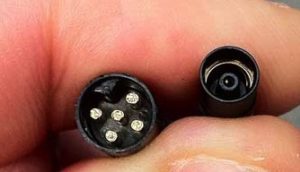 Historic Info on the older first generation 5-wire Shimano Dura-Ace Di2 DA-7970 system and how it compares to the new E-tube 2-wire system:
Historic Info on the older first generation 5-wire Shimano Dura-Ace Di2 DA-7970 system and how it compares to the new E-tube 2-wire system:
Released in 2009, the 7970 operated using a very basic 5-wire electronic system. Each shift button was connected to a different wire; shorting the specific wires together controlled the derailleur upshifts and downshifts. Because the first generation 7970 used completely different technologies than the newer 2-wire systems, none of the components are cross-compatible. At this point, Shimano is not expected to offer any updates or new components using the first generation 7970 architecture; everything from now on will be based on the newer 2-wire E-tube design. The second generation design offers several advantages, which include: 1) smaller wire size, smaller connector size, waterproof connectors; 2) all switches can be reconfigured in software to send upshift or downshift commands to either the front or rear derailleur; 3) firmware updates can add new features (such as multi-shift) and compatibility with new components.
Compatibility: Dura-Ace 9070 and Ultegra 6770 / 6870 (and old 5-conducter 7970)
The confusing naming system used by Shimano makes it difficult to figure out what each component is, much less what is compatible between systems. Here are some compatibility guidelines:
- Nothing from the first generation (4-conductor / 5-conductor) Dura-Ace Di2 7970 system is compatible with any other newer system. It was replaced by the (2-conductor) E-tube systems. No parts are inter-operable between 7970 and any other Di2 System.
- In general, every electronic Di2 component is compatible between the Ultegra 6770, 6870, and Dura-Ace 9070 systems (see exceptions below.) This means that all of the road bike Ultegra/Dura-Ace dual control brake levers/shifts, time trial shifters, and climbing shifters can be used with either Ultegra 6770/6870 or Dura-Ace 9070 front and rear derailleurs. Any of the Ultegra/Dura-Ace controllers (A Junctions) can be used with either system. All components use the same cables and connectors.
- Firmware Update Required to Make Older Components Compatible with Newer Components: If you add a new component and it doesn’t work, update the firmware using the PC USB adapter and the Shimano E-tube Project Software for Windows.
- Synchronized Shifting and Bluetooth Wireless Units can be added to all E-tube Ultegra and Dura-Ace systems but the battery has to be upgraded to the BT-DN110 Internal Battery or BM-DN100 External Battery Mount. To add Bluetooth capability, a EW-WU101 or EW-WU111 inline transmitter must be added to road bikes and for mountain bikes, the SC-MT800 or SC-M9051 display/transmitter unit must be added.
- Compatibility Exceptions:
- Note 1 – Sprint Shifter Exception: The Sprint Shifter is the only exception for shifter incompatibility. It has a different wiring connector (and internal components) that can only plug into a unique/dedicated third port on the Dura-Ace ST-9070 Dual Control Brake Levers/Shifters and also the ST-6870 Levers. There is no sprint shifter port on the ST-R785 Hydraulic Levers.
- Note 2 – Can’t mix 10-speed/11-speed front/rear Derailleurs: It is no longer possible to use a 10-speed front derailleur with an 11-speed rear derailleur (and 11-speed front with 10-speed rear.) See note farther below to read the history on this if you want all the messy details.
- Note 3 – Front A junction and Internal Battery: Since the February 2015 firmware update, the older SM-EW67-A-E Front Junction A is no longer compatible with the BTR2 Internal Battery because it does not have the charging port to charge the internal battery. The SM-EW90 Front Junction (with integrated charging port) should be used instead. The SM-EW67 still works with the external battery.
- Note 4 – Update the Firmware to make components compatible: If the firmware on all components is not updated to the latest version, some components may be not operate correctly with one another. So download the latest E-tube software and update everything and it should work.
- Note 5 – All Shifters work with all 10-speed and/or 11-speed Rear Derailleurs: All of the shifters are compatible with either the 10-speed Ultegra 6770 or 11-speed Ultegra 6870/Dura-Ace 9070 systems as long as they all have the latest firmware. The rear derailleur is the only component that “knows” or “cares” how many rear gears are available. The shifters only send upshift/downshift commands and do not “know” or “care” which gear is currently selected and how many total gears there are.
- Note 6 – SM-BTR1 External Battery and SM-BMR1 Mount firmware updates: The more expensive dedicate service tool (SM-PCE1 PC Interface) must be used to upgrade the firmware on the external battery/mount.The external battery and battery mount can not receive firmware upgrades via the SM-EW90 Front Junction A and the SM-BCR2 PC Interface/Battery Charger. (The SM-EW90 will work in a system with an external battery, but a firmware update can cause them to become incompatible until both are updated independently using the appropriate PC Interface and the Shimano E-Tube Project software.)
- See the Shimano E-tube compatibility chart version 3.4.3 for more details
Compatibility: 11-Speed Rear Derailleur and 10-speed sprockets/wheels
The 11-speed Dura-Ace 9070 and Ultegra 6870 rear derailleurs are designed exclusively for 11-speed rear sprockets and 11-speed Front Derailleurs. Shimano does not provide a way to recalibrate/reprogram them for a 10-speed setup. The sprocket spacing is slightly smaller and the overall range of travel slightly longer on 11-speed systems. If you have 10-speed wheels and 10-speed sprockets, you should use the 10-speed RD-6770 rear derailleur and a 10-speed FD-6770 front derailleur.
Similarly, a 10-speed RD-6770 rear derailleur should not be used with 11-speed sprockets. There will be chatter in some gears, and there might be slow-shifts or self-shifts.
It doesn’t matter which shifters are used; the shifters send upshift/downshift commands regardless of which derailleur config is being used. Shifters do not “know” or “care” which gear is currently selected and how many total gears there are.
Front Chain Rings: In general, most any front chain rings will work, rigid forged rings work best with Di2 due to high front derailleur shift forces. Shimano chain rings tend to be the best, but most others work as well. A 10-speed specific or 11-speed specific chain should be used, but the differences between them are minimal and can generally be mixed/matched without issue.
How to convert “non-upgradeable 10-speed only” wheels such as Zipp 900/Sub9 Disc Wheels to 11-speed: “the spacing between a Campy 11 and Shimano 11 is close enough that you can use the cassettes interchangeably. If you get a Campy free hub body, the 2 shims (part# is on the Zipp website, just search for Campagnolo 11) and a Campy cassette and you’re ready to ride with all 11 cogs available to use.” via slowtwitch.com
But it’s an emergency and I need to use a 10-speed wheel. . . In emergency situations, 11-speed rear derailleurs can be used with 10-speed sprockets. There will probably be chatter in some gears, and there might be slow-shifts or self-shifts. To setup an 11-speed rear derailleur for a 10-speed sprocket setup, adjust the mechanical limit screw so that it can’t shift into the missing 11th sprocket position, then follow the rear derailleur adjustment procedures listed below.
Included for very motivated individuals only: 10-speed front derailleurs can be used with 11-speed rear derailleurs if the shifters and battery have firmware installed from E-tube software version 2.5.2 or earlier. Shimano disabled support for this 11-speed and 10-speed cross-matching with later firmware updates. For informational purposes only, the details of how to regain compatibility are detailed below.
- Important Notice 2014-07-14: There is a compatibility issue with Shimano e-Tube software/firmware versions v2.6.0 and later that prevents 10-speed front derailleurs (FD-6770) from working with 11-speed rear derailleurs (RD-6870) and 11-speed front derailleurs (FD-6870) from working with 10-speed rear derailleurs (RD-6770). DO NOT UPDATE FIRMWARE using Shimano e-Tube software v2.6.0 or later if you are mixing an FD-6770 front derailleur and a RD-6870 11-speed rear derailleur, or a FD-6870 with a RD-6770.
- The problem component is the battery (external battery mounts SM-BMR1 and SM-BMR2, internal seat post battery SM-BTR2.) If you keep battery firmware at v2.0.6 or earlier, the system will continue to function properly. Shimano e-Tube Software v2.6.0 will update battery firmware to v3.0.5, and will not allow the RD-6870 to work with a FD-6770 setup.
- If the battery firmware is updated to 3.0.5, it CAN NOT be rewritten back to the older version. You will need to need to replace a derailleur so that both are 6770 10-speed or so that that both are 6870 11-speed. (The other option is to get get a battery with the older firmware and never update it.)
- Here’s a link to the “last known good version” of the Shimano e-Tube software to work with a mixed 10-speed/11-speed system: E-tube_Proj_V_2_5_2.zip Use this version and do not connect to the internet when using it so that E-tube can’t check for updates when open.
- To roll-back newer versions of battery and shifter firmware, install E-tube version 2.5.2 and made a copy of “C:\ProgramData\E-tube Project\FW” which has all the firmwares packaged in that version of E-tube. Next, install the latest version of E-tube. Then copy all the firmwares from the the 2.2.3 version back to the same location “C:\ProgramData\E-tube Project\FW” for the latest version (note: ProgramData is a hidden directory, click here for details on how to view it.). Next, the trick is to find the firmware you want to downgrade (pretty easy from the name and version in the file name), and then rename it to the same name as the latest version, but increment the last version digit by one. Then connect to the bike with E-tube (without an internet connection) and it will identify that a firmware upgrade is available for that component and allow you to do the firmware “upgrade” to the older version of firmware. Now exit E-tube and then rename the firmware file back to original to prevent the issue in future. E-tube will then try to upgrade again but just don’t let it do that. This should get a bike that did nothing (not even enter adjustment mode) to a fully working state by reverting the battery and shifters. Running latest firmware in derailleurs seems to be fine. (thanks to commenter vosadrain)
- It will not be possible to charge the BTR2 internal battery using the BCR2 USB charger unless you also downgrade the firmware of the BCR2 USB charger as well.
- Note however that latest E-tube software will say the setup is unsupported and will not allow programming. To do programming, disconnect the internal battery and connect a spare external battery. This allows making settings changes. To program the BTR2 itself, I just connect to the BTR2 by itself (no other components) and the E-tube software will allow firmware changes to it. Or try using the 2.5.2 version of E-tube.
- Alternatively, buy a Di2DIY internal seat post battery kit and you will not have to go through the firmware downgrading. The kit makes it possible to run all components with the latest E-tube firmware. Also worth noting some firmware updates were done to fix power distribution errors in the FPGA’s that would allow the batteries to drain down when the bike was just sitting.
Checking Battery Charge Level:
A single battery charge should give at least 1500 miles of riding. Most riders will not need to charge the battery more than twice a year.
To check the battery charge remaining, press and hold any shifting switch for 0.5 seconds or more. The amount of battery charge remaining will be indicated by the light on Front Controller A Junction.
- 100% remaining: Illuminates green (for 2 seconds)
- 50% remaining: Flashes green (5 times)
- 25% remaining: Illuminates red (for 2 seconds)
- 0% remaining: Flashes red (5 times)
When the battery charge is low, first the front derailleur will stop operating, and then the rear derailleur will stop operating. When the battery charge has been fully spent, the derailleurs will be fixed at the last gear shifting position. If the battery indicator is illuminated red, it is recommended that you recharge the battery as soon as possible.
Adjusting the Rear Derailleur Trim:
If you switch between multiple rear wheels, it’s very likely that the sprockets on different wheels won’t be in exactly the same relative position to the rear derailleur, resulting in that annoying clicking sound as the chain makes contact with an adjacent sprocket. Follow the steps below to properly align the rear derailleur with the rear sprockets.
- Shift the rear derailleur to the 5th sprocket position. Press the button at the junction (A) of the SM-EW67-A-E until the red LED illuminates in order to switch to rear derailleur adjustment mode. Note that if you keep pressing the button after the red LED has illuminated, protection recovery operation will begin.
- If shifting switch is pressed once while the initial setting condition is active, the guide pulley will move one step toward the inside. If shifting switch (Y) is pressed once, the guide pulley will move one step toward the outside.
- Note: The guide pulley can move 15 steps inward and 15 steps outward from the initial position, for a total of 31 positions.
- Note: When adjusting, the guide pulley will overrun slightly and then move back in an exaggerated movement so that you can check the adjustment direction. When checking the positions of the guide pulley and the sprocket, check at the position where the guide pulley finally stops.
- While turning the front chainwheel, operate shifting switch to move the guide pulley toward the inside until the chain touches the 4th sprocket and makes a slight noise.
- Next, operate shifting switch 4 times to move the guide pulley toward the outside by 4 steps to the target position.
- Press the button at junction (A) until the red LED turns off in order to switch from rear derailleur adjustment mode to gear shifting mode. Shift to each gear and check that no noise is generated at any gear position. If fine adjustment is needed, switch back to adjustment mode and readjust the rear derailleur.
- Note: if you have customized your shifters and swapped buttons, this will change which shifter and buttons control the micro-adjustments. Also, if you hit the wrong buttons while trying to set the FD trim, you can actually alter the setup of your RD. Be certain that you’re hitting the correct adjustment buttons.
- If you have a Garmin or similar head unit and a SM-EWW01 ANT module, the display will automatically switch into derailleur trim display when you activate that mode (i.e. by pressing the button at the junction (A) of the SM-EW67-A-E.) It will give you the trim position in either + or – 12 positions. When switching wheels, simply take note which position suits which wheel/sprocket/trainer, and trim to that level each time you change. This removes the guesswork and makes changing from wheel to trainer simple.
Note on FD-6870 Front Derailleur Trim:
The FD-6870 trim adjustment effects the auto-trim positions. The adjustment feature is accessible via either the A-Junction box, or the “Front derailleur adjustment setting” in the e-tube software, and should be used only after you have already set the physical inner/outer limit screws. So for example, if the FD outer plate rubs the chain when using the 6th largest cog, you would want to adjust the FD trim outward a couple ticks. However, you can only perform this adjustment while in the big-ring/big-cog combination. Etube forces the derailleurs into this maximum cross-chained position, whereas during the manual method you must shift to these positions yourself. (Thanks to commenter Bryan B for the info.)
Dealer Manuals:
The dealer’s manuals contain the most detailed information available from Shimano. If you’re looking for detailed installation instructions, check here:
- Shimano Ultegra 6770 Dealer’s Manual: http://techdocs.shimano.com/media/techdocs/content/cycle/SI/Ultegra/UltegraDi2/6770Di2_DM_EN_v1_m56577569830773882.pdf
- Shimano Ultegra 6870 Dealer’s Manual: http://si.shimano.com/php/download.php?file=pdf/dm/DM-UL0001-00-ENG.pdf
- Shimano Dura-Ace 9070 Dealer’s Manual: http://si.shimano.com/pdf/dm/DM-DA0001-00-ENG.pdf
- Shimano Alfine Di2: http://si.shimano.com/php/download.php?file=pdf/dm/DM-AL0001-03-ENG.pdf
Shimano E-tube Project Configuration and Firmware Update Software for Windows:
Shimano E-tube Project Wireless for iOS and Android: Announced on April 15, 2016 but as of yet unreleased, these apps will allow configuration of shift profiles (multi-shift on/off, multi-shift delay between shifts, shifter button assignments) and firmware updates over Bluetooth. To function, a Shimano Di2 Bluetooth Adapter, such as the MT800 digital display, is required.
Shimano E-tube Project Windows PC Software: This free software is used to update the firmware of all components. It works with the SM-BCR2 Charger + USB Adapter and the SM-PCE1 Diagnostic Adapter. The software is used to change the configuration of each shift button / lever (any can be programmed to upshift or downshift either the front or the rear derailleur.) It can also be used to enable multi-shift (multi-shift is where the shifter is held and the rear derailleur shifts through multiple gears until the shifter is released.) The delay between of the gear changes during multi-shifting can also be adjusted. The software is available from http://e-tubeproject.shimano.com/
Older versions of the e-tube software are available from these links: 2.5.2
PC & Mobile Interfaces, Chargers, and Software:
SM-BCR1 Battery Charger: This is used to charge the external battery. The part number for the battery charger wall cord is SM-BCC1.
SM-BCR2 Charging and PC Connection: for SM-EW90-A 3-port and SM-EW90-B 5-port A Junctions. This plugs into a special port on the side of the A junctions (which is covered by a rubber flap.) This adapter charges the internal battery when first plugged into the A junction; it must be powered by a standard USB Wall charger (such as that used for an Apple iPhone) or a PC that is powered-on. If the Shimano E-Tube Project Software is launched on the Windows PC with the SM-BCR2 attached, the SM-BCR2 will switch from charging mode to configuration mode. It must be detached from the computer and reattached to switch back to charging mode.
- It takes about 2 hours to charge the internal battery.
- Amber light=charging.
- Light turns off when done.
- If the Amber light does not come on when plugged in, this indicates battery is not discharged enough to charge.
- Light flashing indicates something is wrong, like trying to charge a external battery through a BMR.
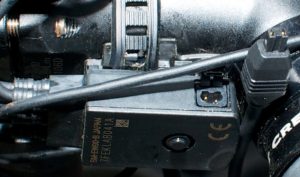
Hacking the SM-BCR2 to have a standard Di2 cable connector: If your 3-port or 5-port junction is inaccessible for charging, there is an alternative hack method to connect it to the system through a standard Di2 port. With basic soldering skills you can hack the BCR2 to be used with any setup. Buy any length EW-SD50 wire, cut off one end. Cut the wire on the output side of the BCR2. Splice the two wires together, so that the output wire of the BCR2 is now a standard Di2 connector. The charger has an inner (white) and outer (shield) wire; connect the inner white wire to the SD50 red wire; connect the charger outer shield wire to the SD50 black wire. You will then be able to plug the BCR2 into any Di2 port. Or use a SM-JC40 junction B and another length of EW-SD50 wire and go through the RD (by using the SM-JC40 to connect the rear derailleur, new output wire of the EW-SD50, and the wire that ordinarily connect the rest of the system to the rear derailleur.) Thanks to @Di2diy for the info.
SM-PCE1: This PC Configuration and Diagnostics adapter will not charge the internal battery. It offers the same configuration options as the SM-BCR2, but also add some advanced diagnostic and troubleshooting features that the SM-BCR2 does not have. It attaches to via the standard E-tube wire (just like the EW-SD50 cables) rather than to a dedicated port on the side of the front A junction.
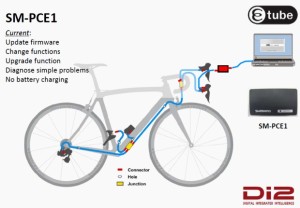
Bluetooth and E-tube Apps for Apple iOS and Android: Bluetooth wireless modules are available to allow system settings to be adjusted via the mobile applications that connect via Bluetooth Adapters.
Component Overview:
The confusing naming system used by Shimano makes it difficult to figure out what each component is, much less what it does and how it fits into an a complete Di2 system. Here’s an overview of all the major Ultegra and Dura-Ace Di2 components.
Dual Control Brake Levers/Shifters (a.k.a. Brifters):
ST-6770 Ultegra Road Dual Control Brake Levers/Shifters: The Ultegra version can be used with the climbing shifters. They are sold in in left/right pairs and are also available separately.
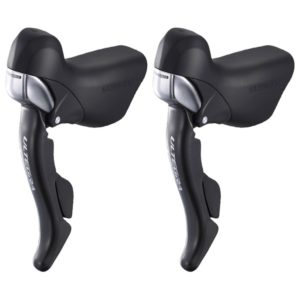
ST-9070 Dura-Ace Road Dual Control Brake Levers/Shifters: The main advantages these have over the ST-6770 version is slightly lighter weight and compatibility with the low-mount sprint shifters. As like the Ultegra version, they are compatible with the climbing shifters. They also have hidden button under the rubber hoods that can activate screen changes on cycling computers from Garmin, Magellan, Pioneer, and Shimano (Shimano SM-EWW01 ANT Wireless Broadcast Module required.)
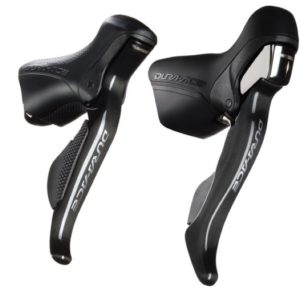
ST-9071 Dura-Ace Time Trial/Triathlon Dual Control Brake Levers/Shifters: These levers provide shifting from the pursuit bar position on time trial bikes. There is no Ultegra option offered at this time. These are available as left/right pairs, or can be ordered separately. These do have a permanently attached wire with a male end for connection the the SM-EW90 front “A” junction. Combined weight both levers: 117 grams.
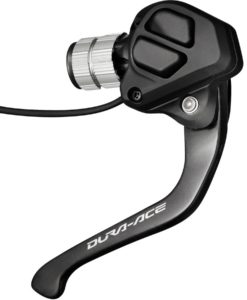
ST-R9160 (standard cable brakes) and ST-R9180 (hydraulic brakes) Time Trial Dual Control Brake Levels/Shifters: These are the lower-profile shifters offered with the newer Dura-Ace R9150 groupset.
ST-6871 Ultegra Time Trial/Triathlon Dual Control Brake Levers/Shifters: Ultegra version of the ST-9071 Dura-Ace shifters. Slightly heavier and much less expensive than the Dura-Ace version. Combined weight both levers: 142 grams.
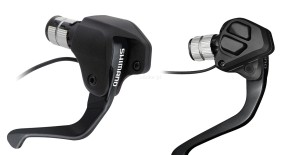
ST-R785 Hydraulic Road Dual Control Brake Levers/Shifters: These hydraulic road shifters are compatible with both the climbing and sprint shifters. These are compatible with the SM-RT99 centerlock 140mm and 160mm rotors and WH-RX31 wheelset (which as no standard rim brake track.) These require the BR-785 dual piston hydraulic disc calipers. They do not have the special wiring port required for the SW-R610 Sprint Shifters and a SM-EW90-B 5-port junction A is required to use the SW-R600 climbing shifter.
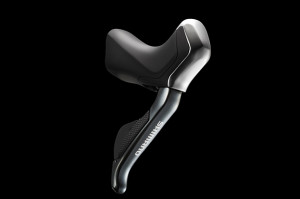
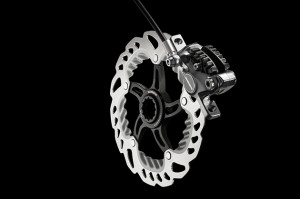
ST-6870 Ultegra Road Dual Control Brake Levers/Shifters: These road shifters are compatible with both the climbing and sprint shifters.
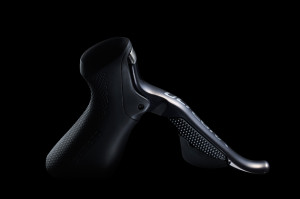
Dedicated Shifters:
SW-R671 Dura-Ace 2-Button Time Trial/Triathlon Bar End Shifters: These shifters are installed on the end of time trial aero bars. By default, the left shifter upshifts/downshifts the front derailleur; the right controls the rear derailleur. For both, the lower button upshifts into a harder gear and the upper button downshifts to an easier gear. This can be changed using the Shimano E-tube Project software; the functions of the left and right sifters can be switched with one another as well. These are available in pairs or separately.
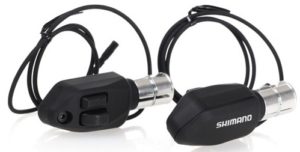
SW-9071 Dura-Ace 1-Button Time Trial/Triathlon Bar End Shifters: These shifters have only one button each and are intended to control only the rear derailleur, with one sending the upshift command and the other the downshift command. (I personally think this version is absolutely worthless. Why have 2 SW-9071 shifters at twice the price and twice the weight, when you can just buy a single SW-R671 Right shifter instead.)
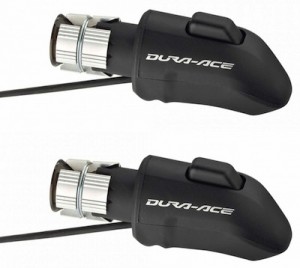
SW-R600 Climbing/PAVE Shifter: This shifter is for road bikes and is mounted on the upper horizontal portion of the handlebar, or any other location comfortable for the rider. They can be used in addition to the Dual Control Brake Lever/Shifter, or can be used on their own by plugging directly into a SM-EW90-A 3-Port Junction or SM-EW90-B Dura-Ace 5-Port Junction.
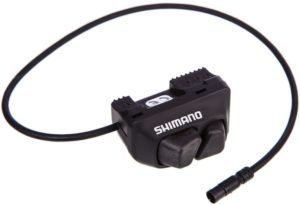
SW-R610 Dura-Ace Sprint Shifter: This is the only component using a unique wiring connector; it is only compatible with the ST-9070 Dura-Ace and Ultegra ST-6870 Road Dual Control Brake Levers/Shifters. Unlike all of the other shifters, the sprint shifters do not contain a circuit board; they do not show up as components on the CAN bus network. Instead, the sprint shifters are simple momentary switches that activate the circuit board on the host Dual Control Brake Lever/Shifter. The host dual control lever is what sends the shift command. (Note: Any momentary switch can be attached to the sprint shifter port on the Dual Control Levers by splicing into a standard EW-SD50 wire to act as remote shifters.)
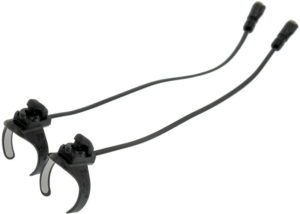
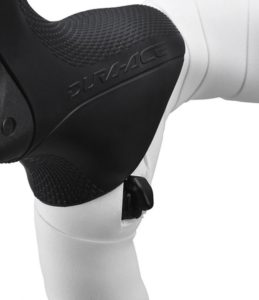
Alfine SW-S705 Right Flat-Bar Shifter: Reported to work with other non-Alfine setups.
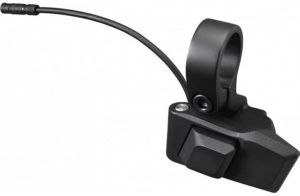
SW-R9160 Time Trial bar-end shifters (pair): These are-end shifters directly control the rear derailleur, with one for the upshfit and one for the downshift. The front derailleur is controlled automatically via automatic Synchronized Shifting. These shifters require the BT-DN110 Internal Battery for synchronized shifting.
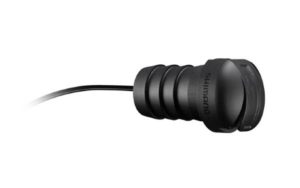
SW-R9150 Climbing shifters (pair): These tiny climbing shifters are about as small as the sprint shifters, but can be directly connected to a junction box and do not have to be connected as slave buttons to a brake/shift lever special port. They come with plastic mounts to make it easier to attach to bars beneath bar tape. They are ideal for synchronized shifting, with one controlling the upshifts and the other downshifts. These shifters require the BT-DN110 Internal Battery for synchronized shifting.
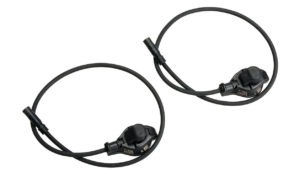

Front Derailleurs:
FD-6770: Ultegra Front Derailleur
FD-6870: Ultegra Front Derailleur, pretty much identical to the FD-6770 but with a slightly larger diameter adjusting screw (to better dissipate the shifting forces).
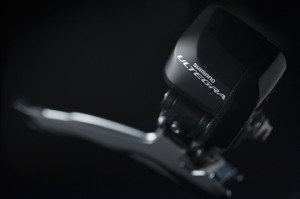
FD-9070: Dura-Ace Front Derailleur
FD-R9150: Dura-Ace Front Derailleur for 9150 systems; features slightly reduced weight vs. 9070.
Rear Derailleurs:
RD-6770: Ultegra 10-Speed Rear Derailleur, compatible with gears up to 28 teeth.
RD-6870: Ultegra 11-Speed Rear Derailleur, compatible with gears up to 32 teeth (for the GS version).
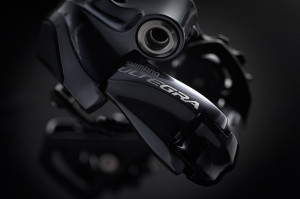
RD-9070: Dura-Ace 11-Speed Rear Derailleur, lighter weight version on which the RD-6870 is based.
RD-R9150: Dura-Ace 11-Speed Rear Derailleur with 30-tooth sprocket compatibility and modified “Shadow RD” geometry to keep the mechanism close to the rear wheel to help avoid damage in the event of an accident.
Alfine SG-S505 and SG-S705: The Shimano series targets comfort and urban bikes. It uses an 8-speed (505) or 11-speed (705) internal epicyclic rear hub. It is believed to be compatible with other Di2 ETube components but this has not been verified.
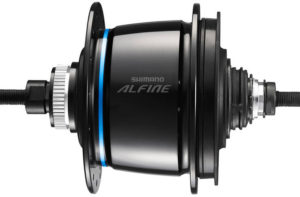
Display / Wireless Communication:
SM-EWW01 ANT Wireless Broadcast Module: This module wirelessly broadcasts Di2 data (front and rear gear selection details, gear ratio, battery life) to a cycling computer using the ANT protocol. It is compatible with Dura-Ace 9070, Ultegra 6870 Di2 and Ultegra 6770 E-tube road shifting systems. SM-EWW01 plugs into the E-tube wiring system between existing components. It has an 2 wiring ports, so it can be connected between a front shifter and the Front Junction A, or at the rear derailleur (between rear derailleur and Etube wire.) It transmits through a proprietary private ANT wireless protocol, which may eventually become a standard public ANT+ protocol. It is powered by the same Di2 system battery. It is currently compatible with the Garmin Edge 1000, Mio 505, and the PRO SCIO cycling computers (with more to come.) The hidden buttons under the hoods of the 9070 shifter levers will switch screens on the cycling computer when paired with this module. It does not currently allow for shifting control from a cycling computer/device and it is not clear that this functionality will ever be offered. The SM-EWW01 is 38mm long, 25mm wide, 12.5mm high, and weighs less than 5 grams. It does not come with any wires; 1 wire would have to be added if adding this module to an existing Di2 system.
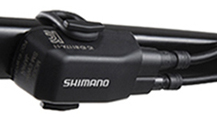
EW-WU101 and EW-WU111 ANT and Bluetooth Wireless Broadcast Modules: These modules are similar to the SM-WEE01 but also include Bluetooth capabilities in addition to ANT capabilities. They require the BT-DN110 battery or the BM-DN100 Battery Mount and cannot be used with the SM-EW67 Front A Junction.
SC705 Alfine Display Unit: This unit displays the battery level and the rear derailleur gear selection. It is powered by the system battery and has a port for the SM-BCR2 internal battery charger / USB diagnostic tool. It is primarily designed for Alfine systems (both 8 505-series and 11 speed 705-series). It is compatible with Ultegra and Dura-Ace Di2.
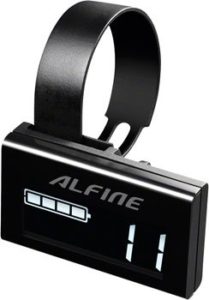
MT800 Digital Display with Bluetooth: Primarily aimed at XT mountain bike applications, this display allows toggling between the 3 synchronized shift modes (where both derailleurs are intelligently coordinated in unison by one pair of buttons, so no need for discrete shifting of the front derailleur.) It also shows battery level, gear position, shift mode and FOX iRD suspension position. The Digital Display required the new BT-DN110 battery. Existing Di2 XT systems are upgradable to be compatible with the new digital display after battery upgrade and firmware upgrade. This display has 3-port Di2 Cable junction and charging port integrated into the back and serves as a Front A Junction.
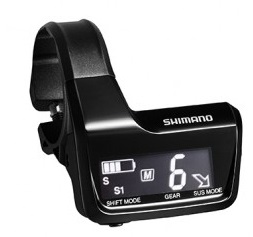
Batteries and Battery Mounts:
The batteries contain the main controllers for the system. It is therefore required to upgrade the battery to get features released in new versions of Di2 (such as Synchronized Shifting that automatically controls the front derailleur based on rear derailleur shifting.)
SM-BTR1 External Battery: This external battery must be used with the SM-BMR1 battery mount. It is removed from the mount and charged using a dedicated charger.
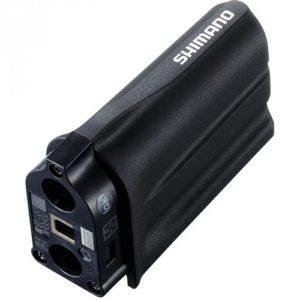
SM-BMR1 and SM-BMR2 External Battery Mount: This mount attached to bottle cage mount points or other dedicated frame mounts. It is available in 3 different mount lengths: -I (intermediate length), -S (short length), -L (long length). The SM-BMR2 is an updated version of the SM-BMR1.
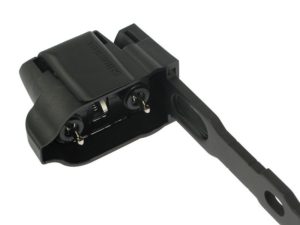
SM-BTR2 Internal Battery: This battery is typically mounted in the seat post or seat tube of the frame. It is charged by plugging the SM-BCR2 Charging Cable/PC Adapter into the SM-EW90-A or SM-EW90-B Front A junctions.
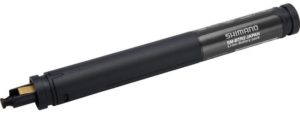
BT-DN110 Internal Battery: This battery is required for Bluetooth wireless units and road groupset Synchronized Shifting functionality.
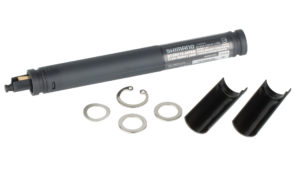
BM-DN100 External Battery Mount: This battery is required for Bluetooth wireless units and road groupset Synchronized Shifting functionality.
Front A Junctions:
SM-EW67-A-E Ultegra 3-Cable Junction: This is the original front junction with 2 integrated cables to connect to the dual control brake lever/shifters. The male cable ends on this Front A Junction will not mate directly to the male cable ends on any of the Time Trial/Triathlon dual control brake shift levers or shifters; SM-JC41 Rear B Junctions can be used to connect this front A junction to TT/Triathlon shifters. This Junction works only with External Batteries, not Internal Batteries.
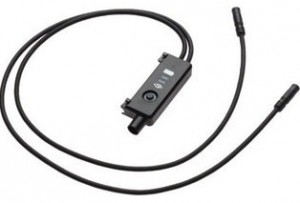
SM-EW90-A Dura-Ace 3-Port Junction: This front “A” junction is most commonly used in road bike setups. 2 ports connect to the dual control brake / shift levers; the third port is for the cable that leads to the bottom bracket junction.
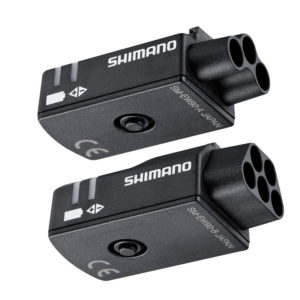

SM-EW90-B Dura-Ace 5-Port Junction: This front “A” junction is primarily used in the Time Trial / Triathlon setups. 2 of the port are for the brake/shifter dual control levers, 2 of the ports are for the aer0 bar bar-end shifters, and the 5th port is for the cable that runs to the bottom bracket (where the B junction joins the wires from the front A junction, front derailleur, rear derailleur, and battery.)
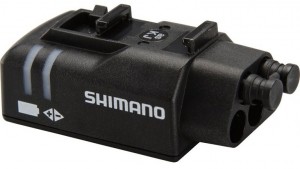
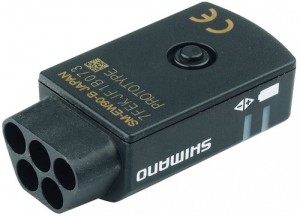
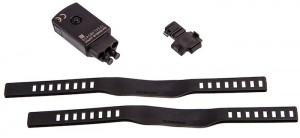
EW-RS910 Internal Bar-end Junction: This junction is installed into the end of a bar or in a dedicated frame port. It facilitates internal cable routing.
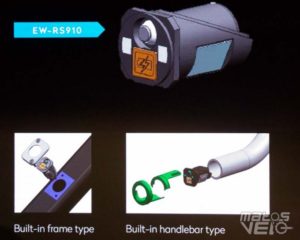
B Junctions:
SM-JC41 Internal Junction: This version has the exact functionality as the SM-JC40 external version, but doesn’t have the mounting tab for being bolted to the bottom bracket or wrapping the extra cable lengths. It has 2 ports on one end and 2 on the other, making it more compact. In addition to being located at the bottom bracket to connect the A junction, battery, front derailleur, and rear derailleur, it can be used at the handle bars to join multiple shifters prior to being connected to the A Junction.
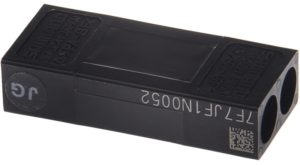
SM-JC40 External Junction: This version is intended to be attached to the frame using the bolt that is commonly located underneath the bottom bracket housing. This junction contains no electronics; it’s sole purpose is to join 4 connectors together, which are usually the wire from the front A junction, the battery, the front derailleur, and the rear derailleur. There are wire holders above the housing to capture the extra wire length by wrapping it back-and-forth.
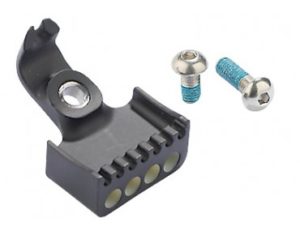
Cables, Grommets, and Cable Remove/Install Tool:
EW-SD50 Cables: These cables connect the front A junction, the battery, the front derailleur, and the rear derailleur to the rear B junction, which is typically located near the bottom bracket (near the cranks.) These are available in lengths of 300mm, 350mm, 400mm, 500mm, 550mm, 600mm, 700mm, 750mm, 950mm, 1000mm, 1200mm, 1400mm.
SM-GM01 Grommet: These round grommets are used when drilling round holes for internal cable routing, or with existing round holes. The required hole diameter is 6mm (6mm = .236 inches. Use a 7/32-inch drill bit and then “wallow-out” the hole to make it a little bigger; a 1/4-inch drill bit will work but is just slightly larger than necessary.)
SM-GM02 Grommet: These 7mm x 8mm oval shape grommets are used in some situations / frame designs.
Shimano TL-EW02 Ultegra DI2 E-Tube Tool: This tool is used to connect and disconnect the Etube wires. They are extremely difficult to connect/disconnect by hand, and pliers or other tools can damage the wires. Don’t get this confused with the TL-EW01 tool, which is for the older 5-wire 7970 cables. (My Dura-Ace TT Dual Control Levers came with one of these tools, but no other components did.)
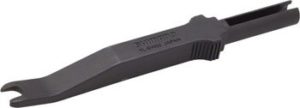
Common Questions (via Shimano):
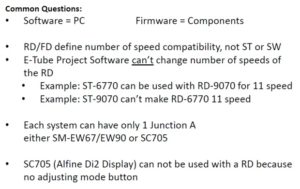
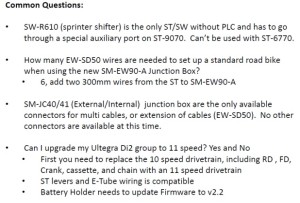
Note: it is not necessary to replace the FD from upgrading from 10-speed to 11-speed.
What Components do I need to put together my own Di2 system?
Because of the huge number and variety of components, it’s very difficult to figure out what is actually necessary and what is optional. So here is a list, for the setup I recommend: Ultegra 6870. It starts from the handlebars and works backwards. (This assumes both front and rear derailleurs, but you actually don’t have to have both; you can pick one or the other and only the corresponding front shifter to go along with it.)
- Any Type of Shifters / Shift Buttons. The Dual Control Brake Levers/Shifters are not required. You can get the just the climbing shifters or Triathlon/TT bar-end shifters, and then potentially add the Dual Control Levers/Shifters at a later point. (The only exception is the Sprint shifters, which require specific Dual Control Levers/Shifters with special ports as noted elsewhere in this article.) Amazon.com link
- EW-SD50 Wires 1 and 2 between the front shifters and the Front Junction A (0nly for some shifters). This is a bit confusing, because some of the front shifters come with wiring attached to them and some of them require purchasing separate wires. In general, most of the stand-alone shifters come with wiring, as do the TT/Triathlon dual control shifters/levers, but the road dual control levers do not. Amazon.com link
- Front Junction A. I recommend the SM-EW90-B 5-port front junction A as it provides the most upgrade flexibility; get the 3-port option only if you’re positive you’re never going to add more shifting components. The older SM-EW67-A-E has 2 wires built-in to connect with each of the dual control shift/brake levers; it doesn’t offer much flexibility or compatibility with a TT/Triathlon setup or adding additional shifters. Amazon.com link
- EW-SD50 Wire 3 between the Front Junction A and the 4-port Rear Junction B connector. Amazon.com link
- EW-SD50 Wire 4 between the Rear Junction B and the Front Derailleur. Amazon.com link
- EW-SD50 Wire 5 between the Rear Junction B and the Battery. Amazon.com link
- EW-SD50 Wire 6 between the Rear Junction B and the Rear Derailleur. Amazon.com link
- Rear Junction B: This is where the wire from the front of the bike is connected to 3 output wires leading to the front derailleur, rear derailleur, and battery. SM-JC40 is for external wiring, SM-JC41 is for internal. Amazon.com link
- Grommets for any place where the wire goes into the frame through a drilled hole. Amazon.com link
- Front Derailleur. I recommend the Ultegra FD-6870 for 11-speed builds or the FD-6770 for 10-speed builds. The Dura-Ace FD-9070 is pretty much identical, just slightly (41g) lighter and 11-speed only. (I do not recommend the Ultegra FD-6770 unless you have a 10-speed setup, because of firmware compatibility issues with 11-speed rear derailleurs. Also, it is an older design than the FD-6870, so it is larger and offers slightly less shifting force.) Amazon.com link
- Battery and Charger. Internal or external, depending on the build. If you have to skill/time/money-to-pay-someone to get everything internal, I highly recommend that option. The SM-BTR2 internal battery has more advanced integrated electronics and is better for firmware upgrades with the SM-BCR2 internal battery charger/PC tool. If you go with the SM-BTR1 external battery, you will need the SM-BMR1 external battery mount and SM-BCR1 external battery charger. Amazon.com link
- Rear Derailleur. I recommend the Ultegra RD-6870 for a new build if you have 11-speed compatible wheels with 11-speed sprockets, or the Ultegra RD-6770 if you have 10-speed wheels/sprockets. The system must be match front and rear derailleurs (both 6870 11-speed or both 6770 10-speed.) Amazon.com link
- TL-EW02 Etube Wire Remove/Install Tool: It takes quite a bit of force to snap the wires in/out. You may think you can get it seated properly with just your fingers, only to then have the wire come loose because it wasn’t fully seated. It’s a good idea to keep one in your saddle bag. Amazon.com link
What wire lengths do I need? This question is impossible to answer correctly, as it’s highly dependent on the frame size and configuration. What I recommend is running string between the component mounting locations to measure the lengths. Be sure to add some extra length, as I find that wires seem to come up short pretty frequently, even when “adding a little extra” to start with. Nothing is more frustrating that having a wire that is 25mm too short. I recommend ordering a few extra wires of multiple lengths and then returning the unneeded/unused wires. As noted above, the standard wire lengths are 300mm, 350mm, 400mm, 500mm, 550mm, 600mm, 700mm, 750mm, 950mm, 1000mm, 1200mm, 1400mm. Do not cut/splice these wires; the connectors on the end of the wires are very small in diameter to start with and you’ll end up with a splice that is larger and less waterproof than you started with.
Acknowledgements: Special thanks to Di2diy for his continued help in the comments. Check out his Ebay store for custom Di2 batteries, harnesses, and components.
Technical Details of the Di2 CANBUS protocol and signaling
Thanks to commenter Ghislain for the details: “I reversed engineered the signal going to the RD. Since I did not have a special tap connector, I could only look at the actual signals in open loop (RD wire disconnected) on the wire going to the RD using an oscilloscope. First, I found that shift up and down are multiplexed on the same wire. A shift down would generate a positive 100 msec clean 8 volt pulse (varies between 50 msec to 500 msec depending on how long you hold the shifter). On the same wire, a shift up would generate a series of 2 msec pulses that would last the same time of a shift down pulse. Therefore, the RD has enough intelligence to discriminate between the 2 types of pulses. When you hold the button on junction A, a 140 msec pulse is generated. But since my RD wire was disconnected, the RD would not go in adjust mode.”
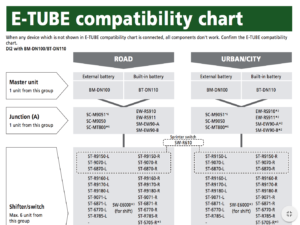
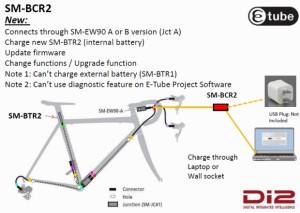
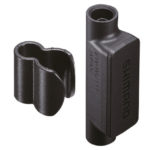
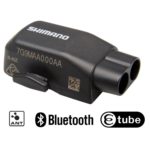
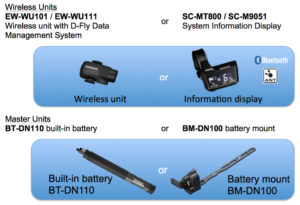
Please could You let Me know what wire lengths did You use on a P2.I intend on using an External battery set up.Thanks
I have Shimano Di2 Systems on two road bikes. dura ace 9070RD/FD Levers R785-r-l battery BTDN110 and controller SM-E90-A and the other Ultegra 6870 RD/FD levers 6770R-L Battery BT DN110 and controller SM EW90-A. I have the latest e-Tube software. I setup autoshift using e-Tube on a PC and semi auto as well but I can not figure out how to activate autoshifting or whether I am still missing something? I press the SM-E90A twice to activate? but that doesn’t seem to work. I have the latest firmware on both systems — can you let me know what I am doing wrong? 52/36 chain ring, standard setup for the shift pattern loaded in the software.
I can only sympathise as I have the same infuriated situation on my R8050 di2
I’ve got it. Changing shift mode needs 2 very very quick blips on the switch. I’ve been doing it slowly. Also, simply holding any of the lever switches for about 1 sec gives battery status and shift mode.
Great site! I have a Cervelo S5 with standard Horn bars, 6780 shifter, aero bars and bar end shifters. I am using a SM-EW90 5 port junction box. I use the bike for long time trials, 12/24 hr. and want to change to regular aero bars. I have a pair of ST-6871 11s shifters I will use on the base bar and will use the same aero bars and bar end shifters. I want to know if the TT shifters will be compatible with the junction box I have or I need another one. Shifters cam with cables and the end plugs look like the same.
I am also building a Dogma F10 as a “climbing bike”. My intention is to use the 6870 brake/shifters on that bike (along with the horn bars off of the S5. I want a new Di2 system for the F10 that will be compatible with the “old” shifters. Will probably also install aero bars and bar end shifters Both new) as well (similar to what I have currently on the S5.) DO I go with a 2nd gen. system or the newer e-Tube system.
Thanks in advance for your help.
Robert
All of the e-tube shifters are compatible. It’s really a matter of personal preference and cost.
I have an Ultegra 6870 Di2 set up all working fine and I’ve been trying to pair my Garmin Edge 1000 with the system. I have an SM-EWW01 connected at the RD but have so far failed to get the Garmin & Di2 to talk to each other. All my tech stuff is Apple. I tried going through the E-Tube application on my iPad which also failed. All I can think of is either; the EWW01 is not working as it should or maybe I have the wrong battery? (Not sure what the latter is but my charger is a BCR2 so am assuming the battery is a BTR2)
The BTR2 will not work, you need a DT‑DN110 contains a new memory chip that is both Bluetooth and ANT+ capable.
I think your problem is that your components need firmware upgrade and the system needs to “recognise” the ant+ unit. I take it you have the SM-EW67-A-E Ultegra 3-Cable Junction with the external battery?. You will either need to “borrow” a PCE unit to update your system or if one of your mates has a Di2 system with an internal battery you can change out the SM-EW67-A-E Unit with their SM-EW90-A junction and update your system via their battery charger and a laptop with the ETube software
Thanks – actually the battery is internally mounted and the junction box A is a 3 port SM EW90. The other reply seems to suggest I need a different battery?
Ok sorry I assumed wrong. The part number of what you said above is for the old style Ant+ only model ( I also have two of them on my Di2 bikes and they work fine, one has internal battery and the other external). I assume that you have already doine this but I will say it anyway….With what you have just said do you have the internal battery charger with the usb that you connect to a PC/laptop? if so have you downloaded the etube software? if so then plug your cable into the A port and let the software recognise your system and do its connection check. On the screen the items will show up on the graphic. then go back to the main screen and you will see a button for firmware update, press that and the system will update the firmware to the latest.
The part number you mention ( SM-EWW01 ) will NOT communicate with your Ipad as it is not bluetooth
Once done get your garmin to look for the ant+ unit for which you may need to set bike up on a stand and change gears a bit till it “kicks” system into action. All being well it should then show the gear page and you will be a happy bunny.
As I hinted before, I have the Ultegra 6870 set up on my bike and that is the one with external battery
Thanks again – becoming clearer – yes I have a charger (SM BCR2) and the USB port/cable but my laptop is an Apple (without Windows) so I’ve not managed to download the E-tube software and make that apparently critical step (hence my attempts through the E-Tube App on my iPad). I guess I’m going to have to find a friendly lbs with a PC who can do the firmware upgrades for me. Still not sure whether I need a different battery?
Try your garmin and see if it picks up the Ant+ part without plugging it in to a PC or take it to LBS, remember you may need to change gears for it to register on your garmin. As far as battery goes , its only the high spec battery that allows the Bluetooth connection thingy to work to allow full access to the etube software on the ipad. The part number you gave is the Ant+ only
Hi Malcolm – finally sorted. Not sure what happened – partial download or corrupted pairing? In the end I tried a basic fix and simply unplugged the d-fly unit from the battery, deleted the sensor from the Garmin, connected everything back together, tried a new pairing and hey bingo, it all now works. Next thing will be a battery & d-fly unit upgrade with Bluetooth so I can mess about on my iPad and shuffle stuff around. Thanks for your help
Great stuff, hope you enjoy. I also am waiting on the battery upgrade (looking on ebay and the likes for a good deal…) I quite fancy the smart gear changing but the basic ant+ data good for now. Glad to help
Carlton thanks for this extremely informative site. So far it has answered all of my questions. So much so, I am about to order the new 2018 Ultegra Di2 upgrade kit. I’ll need to use a 5 port junction port so I can later add the E-Tube bar-end plug. My only worry is getting the cable from the RD thro the chainstay and past the BB. I currently have an internal RD mech cable but it is very thin. I might have a dummy run with some electrical cable to see if it goes thro.
Anyone know what this adjuster does on the Di2 mech?
I have not had a play with it, but wonder if it either takes out any slack in the linkage, or perhaps allows a mechanical “trim” of the mech position (as opposed to the +/- 15 electronic clicks). I cannot see any reference to it in the Shimano techdoc.
Flickr link here.
https://flic.kr/p/23Jgdyf
Could I pick your brains please?
I finally connected the Ew-wu101 today. I have the correct BT internal battery. There were 5 updates needed through the app on my iPhone. I did the 1st 4, but the app crashed @ 48% on the 5th update – the internal battery. Now the whole system is dead. The battery won’t charge. I have the SM-PCE1 box. It won’t recognise the system as it is. If I disconnect the internal battery it recognises everything else (but says the system needs a battery to operate). If I connect the battery directly it is not recognised. Any ideas? It looks like I have to get the battery updated to move forward, but I can’t get anything to recognise it.
Managed to get this fixed. I had to connect the battery directly to the SM-PCE1, then overwrite the firmware by selecting the cable symbol on the right hand side of the e-tube login screen. All updated & all back working again now (Apparently if after 3 attempts the Battery is not recognised, you can tell the SM-PCE1 what it is and that should fix it, although mine worked 1st time).
Hope this saves someone a lot of mucking around down the line (as long as you have access to the SM-PCE1).
Hi I wonder if you could advise on my problem…
I have the required hardware for synchro shift and all firmware is up to date. I’ve been using it (and loving it) for several months now. I recently had to disconnect the battery as I removed the seat post. Whilst I was at it I disconnected and reconnected a couple wires for a better cable run. Now its all back together and I can’t get synchro shift to work.
The button on junction box A still works (to set into bluetooth mode or adjust mech trim), but double clicking does not change between shifting modes. Its basically stuck in mode 1 (traditional shifting) which is working fine on both derailleurs, but I can’t get it to change into modes 2 or 3.
I’d be very grateful if you could come up with a suggestion as to what I have done and how it can be fixed.
Thanks
Patrick, UK
The double click needs to be fast.
About ready to make the jump to electronic shifting, have an F10 frame here which has the removable cap, which -as I understand it- is replaced by a combination charge connector and junction box all-in-one, referred to as an ‘E-link’ port(?).
The bike has been a build project for my son to learn about how things go together, get adjusted, why torque wrenches are important and how to use/store one, etc.
I’m trying to plan out everything I’ll need, but I’m a little confused about which battery, how it mounts in the downtube, and whether I still need an A-junction, etc.
Hunted online for an everything you need to know’ to answer my question, and this seems to be a great resource.
The shifters, FD and RD seem straightforward, and I’ll need cables to connect to those, but it all seems a little vague and mysterious inside the frame.
Thanks in advance for any illumination!
Sorry for the delay. The “E-link port” you describe is the Junction A, so that will work fine. I like how well those integrate!
Thanks for the reply. I took my time, sourced the parts (including the Pinarello-specific seat-tube battery mount) and installed everything last weekend. I ‘roughed-in’ the adjustments on the frame, then trimmed everything on a shakedown ride midweek.
I bench-tested the setup before changing anything on the bike; that reassured me that I hadn’t overlooked anything that I’d need.
Only difficulty I struggled with during the installation was getting the E-tube cable through the chain stay; there was some internal restriction near the rear dropout, and I couldn’t feed the connector through in either direction. -Solution was to cut one connector off about 3″ from the end, and splice the two pieces back together close to the BB. Once that was all done, it really was ‘Plug & Play’.
Since the connectors are coaxial, I had expected to find the cable was also coaxial, but was surprised to see that it’s a standard bifilar cable, with red and black insulation around the two conductors.
The overall jacket material seems like a synthetic rubber, which resists wire strippers somewhat, while the conductor insulation molded inside seems like PVC or similar. -If anyone else ever has to “cut, feed, and re-splice” here’s what I learned: The jacket is most easily removed -carefully- with a single-sided razor blade. I found it best to ‘draw’ the blade edge around the circumference of the jacket, while SLOWLY turning the jacket the other way. -Don’t go so far in that you ‘nick’ the conductor insulation. If necessary, use an over-length E-tube cable so that you’ve got a little extra length to trim back if you need to take 2 or 3 tries before you get the perfect job done.
initial riding impressions are a real delight! -More than a gimmick or a simple convenience, the Di2 really does make shifting a more ‘precise’ experience. -So much so that I’m now looking at sourcing componentry to upgrade my son’s 6800-equipped bike to 6870 Di2!
Thanks for the excellent resource!
Can I use just the climbing/pave shifter SW-R600 for rear-only shifting with non-electronic levers (Campag)? For a new custom gravel build, I’ve learnt from this site (thanks, Carlton) I’ll need to purchase bar-end junction, Junction B, internal battery (& charger), rear der, assoc cables. Anything else I need?
Dan, this looks like a good setup, including the climbing shifters.
Thanks Carlton. I was told that you needed both sides to work. As a matter of curiosity are the brains in the derailleurs ie the levers/shifters send the signals to the derailleurs and the junctions are just connection facilities?
Dan, the system is somewhat decentralized, but the battery is what does the coordination of connected components.
Carlton, probably can file under ” another stupid question”…I bought the SW-R9150 shifter set. Each sifter comes in a separate bag, one pink, one clear with corresponding different part numbers. Is there any difference, like a left and right, or does it matter. Can’t believe the instruction sheet is so sparse!
I think I found the answer…on each shifter there is a small “R” and “L”, so I’m presuming that would be left & right, also the pink bag has the “R” shifter in it. I’m going with that.
Shimano instructions are notoriously terrible. The L/R labels are what you need. I definitely recommend testing everything electrically before running cables.
Carlton, now that I can figure out my left and right satellite buttons, I’m looking for input as to locating them. 😉
Basically you have a choice of using your index finger or thumb actuation, but if you try to locate for both finger/thumb then neither works very well. Have you used or installed the R9150 shifters? I know a lot of this is personal preference, but if do you have any insight I’d love to here it!
John, I hope you got this figured out. I prefer thumb shifting, but I haven’t tried that with the satellite shift buttons you have. I’d try thumb shifting first.
Hey Carlton – thanks for a great page! I’ve just bought a bike equipped with 6770 Di2. I haven’t taken delivery yet but I’m already wondering about tinkering with the system. The chart you and Shimano provide says that the SM-BTR2 battery and the SC-M9050 junction box, which both support synchro shift, are compatible with the rest of the 6770 kit, so is it unreasonable to hope that the 6770 could be persuaded to play along? Is the incompatibility you mention built into the firmware, so that the battery recognises the 6770 RD, for example? Would swapping the RD for a more recent compatible one do the trick?
Robin, you would need to upgrade the front and rear derailleurs (and switch your rear wheel to 11-speed) if you want to take advantage of the new shifting options with the new battery.
Hi Carlton, have a Dura Ace 7970 di2 10 speed Giant. The rd-7970 has died and they are now obsolete! Is my only and cheapest alternative to buy an Ultegra 6870 Di2 11 speed gear set? Thanks for your informative site
Geoff, the cheapest option is to buy a used rd-7970 on eBay or similar. They are show up once or twice a month. 6870 Di2 has a much better future ahead for support, but you will need to upgrade everything on your bike, including the rear sprockets and maybe even your wheel. I recommend the eBay option and being patient to find the right part.
Hi, I´m from Spain, sorry for my level of English. I am a triathlete and I have the new Dura Ace 9150 Di2 in my new Scott Plasma Premium aero TT bike. I´m trying to resolve a big problem for me, when I pedaling in aero position over on the extensions I only can change the gears up with one shifter up and the other down (SW-R9160 Time Trial bar-end shifters (pair) also with ST-9071 Dura-Ace Time Trial/Triathlon Dual Control Brake Levers/Shifters).
Synchronized Shifting is a big product, but for us (triathletes) I think that it does not work very well. I need to drop (leave, release) the handlebar of the bike to change gear if I pedaling over the brakes or over the extensions because the all the shifters are configurated with only one button and command.
My doubt, is it possible to configurate the shifters to avoid to drop (leave, release) the handlebar or the extensions? i.e., if I control the bike over the brakes and I want to up one gear I need to drop the handlebar to push the upshift. I know that the symchronized Shifting control this situations but for triathlon we need more availability options.
i hope that you understand me and help me.
Thank yo very much. Best regards.
You have 2 options: Use SyncroShift with your existing shifters or replace your 1-button bar-end shifters with 2-button bar-end shifters.
I personally use the 2 button shifters. I don’t see any value in having fewer buttons. It’s pretty easy to remember which button does what.
Thank you so much for your answer. I do not yet understand the reduction of buttons from Shimano. Finally I opted to use the Full Synchro option and left side (handle bar and bar-end buttons) up gear (sprockets) and the right side down, the rest to work efficient is done for the Full Synchro option (up/down chainwheels). The problem here is if you need to up/down quickly the chainwheels you only have the buttons to do it, you can not up/down these one.
Best regards.
I saw a neat setup on GCN a few months back where someone with an aero road bike with etap bought an aero tt handlebar and switched between road and tt handlebars only needing to re-pair the shifters (and also change brake cables).
I’d like to duplicate this setup with ultegra di2 to save cost, but this would mean changing cables. Seems like this is doable as long as I have the handy cable tool, but I still worry regularly changing cables will wear them down, or wear down the junction box. Would that be an issue?
If you’re just changing a few times a year, I don’t think connector wear at the Junction A would be an issue.
Hi I’m looking at a new bike and tossing up between Dura ace di2 and Ultegra I have had bike shops say Dura ace shifts better but what I can gather the main difference is weight and price just wondering your thoughts. Thanks
I agree with you; the only significant difference are weight and price. Unless you are an ultra competitor or have unlimited money to spend, it’s very difficult for me to recommend Dura-ace. Ultegra offers identical performance at a significantly lower price.
But Dura Ace does have the buttons under the hoods that allow one to scroll thru screens on their bike computer without taking the hands of the bars. Thats a safety feature for me. Does the latest Ultegra have this?
To my knowledge, that is Dura-ace only. But could use Drua-ace brake/shifters with Ultegra everything else and still spend much less.
True that! For safety the scroll feature should be added to Ultegra. Adding the DA shifter cost to an Ultegra group is still onerous. Etronics aside, ultegra cassettes are more durable and of course cheaper.
I believe the shifters in the latest version of electronic Ultegra – R8050 – do have the same remote switches on top of the hoods as Dura-Ace. However for the next part I’m not really sure, but knowing Shimano, you may need the updated transmitter, WU101 or WU111, and maybe even the most recent battery BT DN110 to fully utilise the remote switches?
Tony is correct – https://www.bikeradar.com/au/road/gear/category/components/groupsets/groupset-road/product/shimano-ultegra-di2-8070-review-51484/
Can you directly connect a 2-cell Li-ion battery to the Di2 wires? (the newer SD50 type)
Are the Di2 wires running a 7.4 v voltage or do the battery holder regulate it down?
Is there a place with pictures? (to ensure i get polarity right)
Hello, Carlton. You know how to solve a lot of problems with di2. I think that you can help me to fix problem with di2 rd-9070. Rear derailleur does not shift to 10th and 11th gear. Firmware updated successfully. I tried to fix problem using crash mode. In this mode RD doesn’t shifts to this to gears too… when I connect my di2 to PC RD sets to 9th gear but on PC indicates 11th gear. Carlton could you help to solve this problem? RD wasn’t damaged never. One day it’s stop working correctly.
The most likely issue is that the limit screw needs to be adjusted and that you basically need to go through the entire setup procedure again. See the Shimano 9070 Dealer Manual for full details. http://si.shimano.com/pdfs/dm/DM-DA0001-09-ENG.pdf
Hello, Carlton. Today I learned shimano manual. Setup procedure did not help. I tried to setup using pc and Etube programm. Programm shows me that I should make a request to Shimano. May be it is mechanical problems?
Yes, most likely a failure internal to the derailleur. The dealer setup process would have fixed it otherwise.
Good Day Carlton, i run 3 bikes with the 9070 groupset. i am a mobile bike mechanic. i have all the latest software and components. when i activate “Synchro-Shift” on either bikes, i get a tremendous battery drain overnight. it was down to 15% yesterday after a full charge the previous day, if i disable the s/shift, there is no battery drain. can u please give me a soiution? my limit screws are all adjusted perfectly. thanks
There is a known battery drain issue with older versions of firmware. Have you updated to the latest version of firmware?
yes, i have the SM-PCE1 and the BCR-2. battery is the BT-DN110 and i have the EW-WU101.
But have you updated the firmware?
Hello Carlton. I have a pair of Shimano 7970 shifters,can I use them with Ultegra 6770 front and rear deraillaur? There are a 5-pin Cable after the box from the shifters….And if not,what kind of Cable harness do I need?
Regards Sven Sweden
7xxx equipment is not compatible wit any of the other di2 generations. completely different cabling
I have Ultegra 6870 on my CX bike. I want to replace my Ultegra RD-6870 rear derailleur with an XT RD-M8050 derailleur, but I don’t want to replace my Ultegra FD-6870 front derailleur. Will this work?
I want to do this because I want to run an 11-40 cassette and a 34-50 chainrings together. I’m currently using a Wolf Tooth RoadLink to do this. Although this works, I’d prefer to run the XT RD-M8050 derailleur because it has a clutch.
This will not work. FD and RD need to be same generation.
My bike is three years old with about 19,000kms on it. Since Chistmas, twice when I was out on a ride and the battery indicator was flashing green at the start, after about 45 km, the front derailuer went to the small ring & no more shifting. Indicator was now red solid. The second time this happen, yesterday, it was flashing green for the last month, and three rides, 200km. …My question is, am I looking at a new battery or do I have a abnormally high energy consumption with my derailleurs?
Sold green =100-50%, flashing green =50-25% flashing red =25%-dead. All lithium ion power sources drop off sharply after 50%, and more so as they age. Change the battery after you notice is flashing since you don’t know how log it’s been >50%.
I have recently converted my shiv tri bike from 6800 (mechanical) ultegra to 6870 (Di2) Ultegra. I have set up both Derailleurs as per the shimano manuals and everything works well. However when setting the “top position electrical adjustment” on the front derailleur I cannot get the specified 0 to 0.5 mm clearance between the chain and the inner guide plate of the front derailleur. The clearance is around 1 mm with the front derailleur fully adjusted over (to the outside) in “adjustment mode”.
That is, the front derailleur is at the end of its limit in adjustment mode. The gear changes work perfectly across the whole range so I am being a bit picky in not being able to get the above adjustment “as per the book”.
Unless there is a way of getting more range of electrical adjustment then the only way that I can see to get the specified clearance is to physically move the front derailleur mount away from the frame slightly (the derailleur is a braze-on type). This would mean inserting say a 1 mm shim between the frame and the derailleur mounting bracket. As the mounting plate is riveted to the carbon frame I don’t propose to go to that extent of trouble.
Is there an easier way to get this adjustment??
If it works smoothly, makes no noise and changes ok then stop worrying 🙂
Yes that’s the conclusion I had really come to. Thanks
Is it possible to mix XTR di2 fd with road RD-6870 using firmware?
All past experience indicates that mixing works. That can change at any time. Let me know if you encounter any issues.
Carlton, I came across your website, very good information. My question is, I connected all the components and I get nothing, no lights in the A-Junction box, nothing when holding shift buttons, TT bike bullhorn and bar-end shifters. Battery is charged, pen tested it. Ordering the PC E-Tube testing system but wondering if it’s possible to pintest the cable just to rule them out as the cause or will the E-Tube testing system identify bad cables?
Components: Ultegra 2017, Master Unit:SM-BMR1, Junction box A: SM-EW90B, Junction box B: SM-JC40, Shifters: ST-6871, SW-R671, Derailleurs, RD and FD-6870
Thank you
One way to check the cables is to plug one cable at a time into the battery and Junction A. You should see the green light illuminate each time you plug into the junction. If no green light it’s a bad cable, bad battery or bad junction.
Wow!! Bloody awesome article mate!
I have a Di2 6770 10spd bike and thinking about going 11spd and upgrading the firmware to synchro shifting.
I have the SM-EW67 Front A junction, and at this point don’t want to upgrade to the EW90.
Getting:
FD 6870
RD 6870
BM-DN100
SM-PCE1
6800 chain/cassette
Will the SM-EW67 support sequential shifting?
Anything else I need to get this to work?
Thanks.
Unfortunately, according to Shimano, the SM-EW67 is not supported by the newer battery firmware required for sequential shifting. So if you want sequential shifting, you’ll need to upgrade to a new Junction A.
Ok cool, thanks for the info.
Another question. With the SM-EW67, can I go with the BM-DN100 and EW-WU101 and have Bluetooth, or does the SM-EW67 not support that? Thanks again!!!
I think the problem with the SM-EW67 is that it can’t charge internal batteries, and that is why it is not “approved” for use with internal batteries. It should work with external batteries.
Great article.
I’m converting my ultegra 6800 tri bike to ultegra 8050 di2 and have a few questions. Does anyone know if the 8050 FD is compatible with a 6800 crankset? I’ve heard there are some slight differences. Also, is anyone able to explain what the EW-WU111 offers and is it essential?
I’m about to order the parts, i’m leaving the wires out as i’ll get the bike shop to install it and get the right length at the time.
– base Bar and aero bar shifters
– 8050 FD and RD
– BT Dn110 internal battery
– SM BCR2 di2 charger
– SM JC 41
– EW 90 – B 5 port
– EW- WU111 e-tube.
Is there anything missing?
THanks for your help.
I’m not sure for the crankset compatibility. Everything else looks good.
The EW-WU111 is definitely not essential. It allows you to view gear and battery details on your Garmin (or similar) device via ANT/ANT+. It also allows you to change shift settings using an iOS or Android device connected over Bluetooth LE.
In addition to the list of features Carlton listed for the EW-WU111, it can also be used to update the firmware on the components. In my case and assume this is true for all users, the EW-WU111 firmware can only be updated using the iOS or Android app.
I have a rear derailleur adjustment problem. The system has 32 increments of lateral adjustment. On a typical setup you would expect the initial neutral installed position to be such that you would be somewhere near the middle of this range. Then you would have scope to adjust 15 or so increments either way – more than enough to accommodate tolerance variations when using different wheels. When the dealer supplied my bike he avoided pointing out to me that the neutral installed position was hard up against one side of the range, and I only found out much later when it was too late to do anything about it. Nothing to do with the wheel by the way. I’ve had the same problem with every wheel I’ve had in there. Maybe it was faulty from the get go? I don’t know and we’ve basically fallen out. The question is, is it possible to set this installed neutral position in some way? An adjustment screw? A trick of some sort?
I’ve asked this question before but don’t think I got an answer, and I’m not optimistic I’ll get one now. If anybody has any insights I would be mighty grateful. Cheers all.
Sounds like your frame is bent (manufacture or crash damage), hanger is bent, or the rear mech is twisted. Have the jockey wheels been removed or replaced with oversized ones?
Since you state that this problem exists with every wheel you try, it would suggest that the issue is related to either the bike or the mech.
Another thing to check is the condition of the frame, particularly the inside edge of the drop outs. If these are damaged, you will see movement of the rear mech when you clamp the skewer, which could be sufficient to cause misalignment.
1:/ Your dealer should have a Derailleur alignment tool. Ask the dealer to use this to check if your derailleur / hanger is out of alignment. If the hanger itself is bent, either replace it with a new one (always a good idea to have a spare one anyway !!), or remove it from the bike before you try to straighten it. They are designed to break in the event of too much load. Also, you could break your frame with a little too much pressure (especially carbon).
Once you have established that the frame and hanger are in line…..
2:/ Put the gear into 5th (straightest chain) and run a straight edge (e.g. a long ruler) along the cage towards the crank. It should be pretty much perfect.
3:/ Look at the jockey wheels. The top one should have a little bit of “float” movement (sideways play). The lower one should be fixed. It is very easy to get this wrong if the mech has been stripped for cleaning.
4:/ Slacken off both of the 2 screws holding the jockey wheels in the cage and carefully re-tighten. This will help to take out any twist-misalignment caused by assembly.
5:/ Check the rear mech for vertical alignment. The cage should be vertical and parallel to the wheel/cassette
6:/ Check that the jockey wheels are parallel and in line with each other. The Jockey cage is quite easy to bend out of alignment. IF you strip the cage, one of the side plates comes off easily. (Do remove the mech before trying to straighten them).
5:/ Refit everything and set the micro adjust to mid range and have another go at adjustment, including hi-lo limits and B-screw.
Your RD hanger is likly out of alignment.
https://www.parktool.com/blog/repair-help/rear-derailleur-hanger-alignment
Thanks, but I don’t think that can be it. I should have said the derailleur has been on two different frames with the same problem. It occurs to me that if there were a washer between the derailleur and the hanger (should there be?) this would push the derailleur further out and might solve the problem. Any thoughts?
I had an issue with RD shifting. I kept tinkering with the Di2 adjustment. Shifting would work on some gear changes and on some specific changes it would not work well. I built a RD alignment tool for around 10$. A 0.75 inch square hollow steel / Aluminium tube, a M10 bolt around 40 – 60 mm long and couple of nuts and wide washers. You can use a Triangle/ruler to measure the misalignment at various points on the Rim, once u mount the tool to the RD hanger. You can use the same rod to bend the hanger into alignment. I can post some pictures of my tool, if anyone wants
Martin. A picture or two would be appreciated.
Great article. Thanks a lot! I have a Ultegra Di2 6870 set (Trek Emonda SL7 Disc) with a Profile Design T4+ aero bar, and I am shopping for an shifter extender. Does anyone know if the SW-R671 is compatible with the Ultegra Di2 6870 (11 speed)? If not, anyone has a recommendation for a shifter extender compatible with 6870 and the aero bar?
Yes if you use the external battery.
Awesome article, so much info. I have read through but can’t find anything on this so forgive me if I am repeating somebody.
I have a TT bike with di2 and synchro shift enabled. I have the single button brake shifters and the single button extension shifters. I have full synchro enabled and it is currently on the default shift map setting. I am running a 36/52 front and 11-28 rear. What would be the optimal shift mapping setting for triathlon (hilly course).
Thanks
I had the same set up on a Cervelo P5 with single buttons and syncroshift working the rear mech on the buttons and the front mech automatically by synchro.
I also installed a R600 climbing switch to the basebar so that I could force the front mech over quickly. (This did require a second junction B and another short cable, but worked very well.
When the battery on my wife’s 2012 ultegra di2 10 speed dies can it be replaced with one of the newer seat tube versions? Shimano seem to have stopped making replacement batteries for the original di2 and I a man worried the whole system will become obsolete.
It will depend on the rest of the Di2 components. Shimano publishes a “Compatibility Matrix” which you can use to determine supported configurations.
Firmware revisions may also impact compatability, the matrix will help here also.
Try this link to the matrix.
https://www.google.com/url?sa=t&source=web&rct=j&url=http://e-tubeproject.shimano.com/pdf/en/HM-CC.3.3.0-00-EN.pdf&ved=2ahUKEwju7YON1e3aAhUJw2MKHfHEDLAQFjACegQIBBAB&usg=AOvVaw2STRibmRUC-xRmhYAzXGCO
Thanks Jim, I’ll take a look at the chart and see if I can figure it out – and work out if it’s not just better to upgrade the groupset to 11 speed and start with scratch
Howard, I have the original 10-speed Ultegra. All you need to do is install a new battery and update all the firmware. If you have the original EW67 Junction A, that may be replaced as well. Upgrading to 11 speed is a much more complicated and expensive ordeal that I think is very difficult to justify given limited advantage.
Hi,
I have just bought a new bike fitted with the latest version of Di2 Ultegra (R8000). I am so far unable to pair the Di2 with either my Garmin (Edge 810) or link it to the E-Tube app.
The lights on the Junction Box don’t flash when I press the button for 0.5 seconds as indicated in some instructions. However, a double press does make them flash which reading from earlier posts seems to indicate what synchro shift mode it’s in, which seems to suggest it’s got the latest firmware.
How to I pair with my devices – one of the reasons I went for a bike with the newer version of ultegra was the added functionality.
Just checking, did you get a option of the EW-Wu111 wirless unit ? This does not come as standard. If you do not have one, you will have to get a short length of DI2 cable.
No, there wasn’t an option. I’ve seen the wireless unit on the shimano website when looking for information and assumed it was included in the build for the new groupset. I’m guessing this isn’t the case?!
The EW-WU111 is and add on and purchased separately. This is the magic piece that allows you to use the E-Tube App and connect to your Garmin 810.
Assume your new build has an internal battery in the seat post. My EW-WU111 connects just below the battery with a short Di2 wire and I have had good performance. This may not work well with a metal frame.
You will also need the DN-110 (internal or DM-110 (external) battery as you need the memory function.
I have the exact same set-up, WU111 sitting in the down tube below the battery ( I wrapped mine with a little bubble wrap to counter any rattling), it works perfectly (carbon frame) and is much better than the alternative transmitter WU101 which is normally mounted externally (and not very elegantly) on the seat stay. You should also check you have the latest battery, DN110, as the e-tube app/bluetooth connectivity will not work with the older BTR2 which doesn’t have bluetooth capability
I have Di2 on my bike, set up for synchro shifting which it does fine BUT a bad bump on the road “bumps” the chain off the big ring onto the small ring with ensuing confusion to me and the set up. Any clues?
I haven’t experienced this. Most likely, you have either a front derailleur alignment issue or a chain length issue. The Shimano dealer install manual goes though of all of the adjustment requirements for both.
Thanks for your comments. I’ve taken a link out if the chain and rechecked the FD settings. The electronic setting as described in the manual doesn’t seem to function – never has so I wonder if that bit doesn’t apply to the latest software for synchro shifting. I’ll see how it all goes when I ride on Sunday. Thanks for your advice – always nice to know that someone will respond to these niggles.
Try coming out of Snychro mode and do the micro adjustment on the front mech according to the manual.
Then re-enable the Synchro.
Be very critical of the mechanical settings of the front mech. (distance from chain rings, angles etc.)
Thanks to both. I took out a link in the chain and as suggested fiddled with the FD in manual mode. Didn’t “bump” off the big ring today, so that’s a plus. Although, rather than bumping off the big ring I do find that occasionally the Fd moves over to drop the chain onto the small ring. Is this me? -I have carpel tunnel syndrome in my left hand and basically, after about 20 miles I have no feeling in my left hand at all – synchro shifting on the right lever helps an awful lot with this, but occasionally as I say, the FD moves over to the small ring. I’m thinking of bypassing the left lever in case its my left hand nudging the down shift lever. No problem with that just the pain of taking all the bar tape off. I need a female/female connector – is that EW-JC200? As a temporary measure I can pull back the bar tape at the lever, pull the two wires out of the lever and plug them into the connector. Sound OK?
For the first part of your question. If the battery voltage drops below a certain value, say 6.3 volts, if the chain is on the outside chain ring, the FD will drop the chain on to the snall chain ring. You then will not be able to get it back up, untill you charge youur battery. The question is if after the chain goes to the small chain ring, have you tried to get it back up to the larage ring, If you have then it maybe you touching the switch. I have noticed if I hire a bike on hols, and it is mech, I do then to miss change gears for a few days after getting home, as well as tring to rip the shifters out of place.
Hi. Fantastic article!
I have ultegra di2 with the old SM-EW67-A-E Ultegra 3-Cable Junction. I want to install TT bar end shifters. I notice there is a spare port on each of the st 6770 shifters. Can I simply plug the SW-R671 cables into these ports or do I have to buy a 5 port connector and new wires?
Thanks for any help
Andy.
Those ports only work with the climbing shifters.
https://carltonbale.com/shimano-di2-everything-you-need-to-know/#shift_brake_levers
Ahh ok thank you. I take it I’ll need to buy a 5 port connector and 2 new wires for the existing shifters?
Kind regards
Andy.
Exactly!
Hi, I have di2 6770 front and rear mech, with external battery btr1 and the battery I’ve had for 3 years is almost dead and have read about the issues online around replacement batteries ages, so perhaps might look at upgrading to a new battery series. – newer batteries perhaps that may negate this. If I want to keep the current shifters and mech, is it possible to upgrade the battery /wires etc
Based on the latest E-Tube Compatibility chart, you should be able to upgrade to the BM-DN100. Here is the URL for the chart: http://e-tubeproject.shimano.com/pdf/en/HM-CC.3.2.0-01-EN.pdf.
As for battery life, 3 years is pretty typical for almost anything electronic with rechargeable batteries.
Great website..Lots of info..I’m new to bike mechanic’s and di2 components. Wife has Dimond bike with 9150 derailleurs, sm-bcr2 charger, sm-ew90B, not sure on battery model,but the build is pretty new.
Problem is : the bike quit shifting, the battery makes a grunting noise about 6 or 7 times but the derailleurs dont shift, on the 5 port box the green led light comes on solid (i think means full charge?) but after a couple of seconds the led light next to the battery indicator light comes on red?
any advice would be greatly appreciated. Thanks
Update, found where a small screw looked like it had backed out on the bottom derailleur and the rear derailleur was jammed up against the bottom of the bike frame. Tightened up that screw and now the derailleur cant hit the bike frame. But now even weirder both buttons on the right side of handle bars( bar end shifter and button by the brake both cause the rear derailleur to go down(smaller cog).
Hallo, really usefull guide & info sheet.
I would like to know how i can find out wich firmware i have at the moment?
im planing in future to place 11 s rear der instead of 6770 10s
You will need to hook your bike up to the e-tube software to determine the current firmware. What model year is your bike? Have you ever upgraded the firmware?
i have never upgraded firmware.
bought this bike from conti team few years back. the bike is 2010-11 year.
Have no idea if they upgraded firmware.
when i hook bike to e-tube does it automaticly updates firmware or i can accept or decline that? (if it’s out of date e-tube will surely try to update, i thinko so.)
I have a project whereby I wish to consider Di2, but cannot drill out the cable holes in the frame. These measure 4.2mm diameter for normal brake cable outer.
Therefore I will need to cut the end off the E-tube cable and solder it back together once threaded through.
Any issues i might experience, or tips? (external wiring is NOT an option.
I cut one of my spare cables and added in the test ports for the use of a multimeter to record the voltage and current. It is just two standard core cable, no screening. Just cut, solder and tape up each core. But just before that, get some heat shrink (with glue) from an electrial wholesaler and put that on first. Allow it to overlap by about 10mm over the outer core on each side. I would buy a few sizes and try it out on cable of a similar size, because you can get the shrink that will shrink from a large size down to a small size, but you might find that it is too thick and might be ungainly afterwards. Try to make sure the heat shrink ends up no closer than 50mm from the push in plug. This will reduce a bit of tension. You can get coloured heat shrink if you really want to stand out. This is a easy job so give it a try, best of luck.
Thanks for the very useful article , i’m looking to buy a R8050 Di2 groupset , my frame don’t have any kind of internal mounting , so only option is to go with external battery “SM-BTR1” and external battery mount “BM-DN100” , i’m buying SM-EW90 Junction A with the group .
Q1 . As per my understanding , BM-DN100 is enough for the syncro-shifting to work , even if i’m working with older model external battery “SM-BTR1” Am i correct ??
2 – I’m not buying the wireless unit , i’m looking to the ability of customizing my group via e-tube pc app … Can i use SM-BCR2 charger with the “BT-DN100+SM-BTR1+SM-EW90 Setup” for charging battery through Junction A and connecting group to PC ?
Hytham: Yes, you are correct on everything.
Thanks for the reply ..
– So to Confirm i’ll buy SM-BCR2 charger “And NOT SM-BCR1” plus the SM-BTR1 Battery plus BT-DN100 Mount and the SM-EW90-A Junction .
I’ll Use SM-BCR2 for BOTH charging and PC connection ,
– i’m just checking as R8050 group guide guide shows SM-BCR2 can be used with BT-DN100 for PC Connection :
http://si.shimano.com/pdfs/dm/DM-R8050-01-ENG.pdf
– E-Tube Compatibility Guide and your article shows that BT-DN100 enables sync-shifting
http://e-tubeproject.shimano.com/pdf/en/HM-CC.3.2.2-00-EN.pdf
But R8050 Guide shows that SM-BCR1 should be used for charging of SM-BTR1 , No where certify that SM-BCR2 can be used for charging of SM-BTR1 via SM-EW90-A Junction ..
I’m trying to buy one charger to cut cost .
Thanks in Advance , sorry for long comment
Thanks alot for the reply ,
So to confirm i’m gonna buy SM-BTR1+BM-DN100+SM-EW90 And Use SM-BCR2 “NOT SM-BCR1” for BOTH charging and E-tube PC connection .
Problem is R8050 Product Guide and compatibility guide shows that BM-DN100 is compatible with SM-BCR2 for PC Connection but also mention that For charging of SM-BTR1 , SM-BCR1 should be used , I found no where certify that SM-BCR2 can be used to charge SM-BTR1 via EW90+BM-DN100 .
I’m trying to buy 1 charger for both functions “charging/PC Connection” ..
Sync shifting should work without FW upgrade “BM-DN100 should be up to date”, right ?
As long as all components are on the same firmware revision, and that revision supports sync shifting, you should be fine.
I don’t believe the PC adapter can charge external batteries. I think it only charges internal batteries. But I’m not positive about that.
Many Thanks for the excellent guide , and your kind support
I have 6870 36/52 and 11/28. If i damage my RD-6870 GS in a fall, can /I upgrade to the new R8000 RD? If I replace my front crank with a new R8000 one, would you be able to adjust the FD-6870 enough to work with this crank. If I have to change the front FD, will the 6870 shifters be OK?
Lots of questions 🙂 Yes the 8050 Di2 RD will work with 6870 system but you may well need to do a firmware update using Shimano etube. The 8000 crank is a direct swap for the 6870 so you shouldn’t need to adjust the FD mech at all, the shifters are still fairly dumb switches so yes they will work with 8xxxseries kit, but see note on firmware update as above. Hope this helps
I thought the crankset for the R8000 had a 0.5mm difference in spacing between the two chain rings, this does not sound like much, but does are people able to adjust it out?
Kevin – I’m running a 6800 crankset (52/36) with an r8050 RD and I’ve not noticed any issues so far. Hopefully there’s no nasty surprise waiting to jump out at me!
My question is if you have a R8000 crankset and a FD6870, will they work ok and if a FC 6800 crackset work with a FD8000 di2 front derailleur. The reason is If I break some thing and the part is unavailable, that I have the option to use the R8000 parts on my 6870 system.
Kevin – my understanding is that with Shimano 6850 & r8000 the components are pretty much interchangeable so you can mix & match. My complete set up is; r8000 shifters (worth getting for the extra buttons on the hoods and much cheaper than DA), 6850 FD & Crankset, r8000 RD & Cassette, DN110 internal battery, EW90-A junction & EW-WU 111 transmitter. I can’t imagine there would be an issue using a r8000FD with and 6850 crankset but I’ve not tried that mix in practice
Kevin – just for clarity where I referenced r8000 components in my earlier reply I did of course mean r8050 which is the Di2 version of the groupset
Thanks alot for the reply ,
1- So to confirm i’m gonna buy SM-BTR1+BM-DN100+SM-EW90 And Use SM-BCR2 “NOT SM-BCR1” for BOTH charging and E-tube PC connection .
Problem is R8050 Product Guide and compatibility guide shows that BM-DN100 is compatible with SM-BCR2 for PC Connection but also mention that For charging of SM-BTR1 , SM-BCR1 should be used , I found no where certify that SM-BCR2 can be used to charge SM-BTR1 via EW90+BM-DN100 .
http://si.shimano.com/pdfs/dm/DM-R8050-02-ENG.pdf
I’m trying to buy 1 charger for both functions “charging/PC Connection” ..
2- Sync shifting should work without FW upgrade “BM-DN100 should be up to date”, right ?
Sorry for long comment , Thanks in advance ,,,